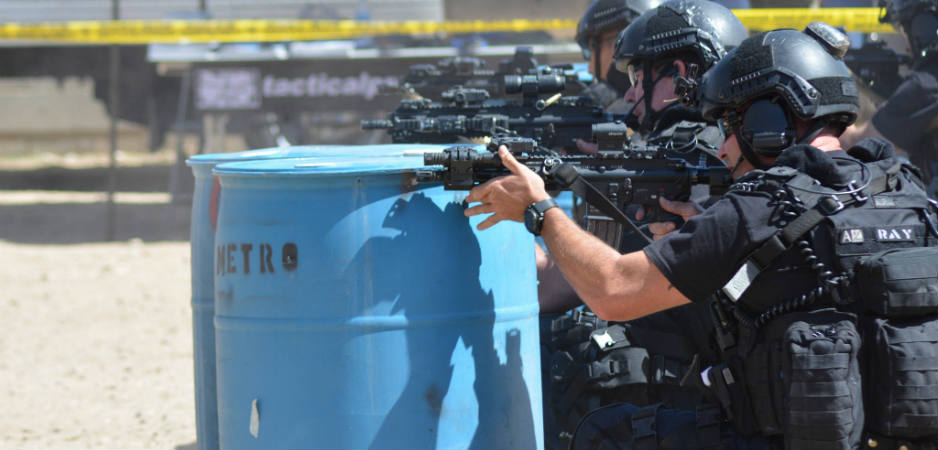The ongoing policies to prevent radicalization are woefully lagging behind in the US.
The struggle against terrorism, and in particular the fight against modern Islamic extremism, could well be described as Sisyphean rather than Herculean. Governments, security agencies and police forces face an impossible task every day, where at many times a tip-off or a lucky break can make all the difference. So if the fight is all but impossible, surely society should do everything it can to constrain the threat.
America has now witnessed two mass shootings where the perpetrators have claimed allegiance to the so-called Islamic State (IS). In both cases, these attacks were carried out by individuals who fit that dirty phrase in the US: homegrown extremists. America now finds itself on a discordant political footing, with three significantly concerning flaws in the fight against radicalization.
Prevention
The US has flexed its muscle when it comes to international counterterrorism operations, whether through military action, its vast intelligence agencies or a softer diplomatic approach. The track record is there to be seen—both successes and failures. However, what America has done at home is astonishing in its sheer lack of foresight and planning: The ongoing and developing policies to prevent radicalization are woefully lagging behind in the United States.
Post-Iraq, America was at the forefront of new counterterrorism and counterinsurgency doctrines, but it simply overlooked the potential of ever facing a tangible and significant localized threat at home. In June 2011, the Obama administration published the National Strategy for Counterterrorism, which was followed in August that year by the White House paper, Empowering Local Partners to Prevent Violent Extremism in the United States; this is, in essence, the US domestic counter-radicalization strategy.
A significant unease has been almost-sectarian nature of the strategy. The government has opted to hold back, due to the traditional approach of state and religion remaining separate, not wanting to fully address what it perceives as a religious matter. While there are now pilot programs running in some states to involve communities, there is clear concern that strategy simply doesn’t go far enough but, instead, has held a more traditional stance of securitization aiming to cut communications of radicalized groups, disrupt the message and remove those guilty of spreading an extreme version of Islam. This approach sits firmly in the hands of police and authorities, reducing the issue to a more simplistic “war on terrorists” opposed to the ideological challenge it faces.
The policy stops short of the approach adopted in the United Kingdom’s PREVENT strategy, where the policy moves further, adapting to local communities, faith groups, identifying social risks, with schools and universities now mandated to report suspected acts or signs of radicalization. It has, in fact, been suggested that the approach in the US may have compounded the problem further and created chasms between the Muslim community and the government, creating an “us and them” dynamic.
Britain does also actively use securitization elements of preventing radicalization and tries to dampen any kind of involvement or opportunity to increase curiosity through travel bans and even the confiscation of passports, as well as the outright banning of extreme groups. But there is the understanding in Europe that research on why people turn to radicalism in the first place and the harder approach of securitization are not enough and must be complimented by a softer approach in partnership with local communities.
For too long the US has ignored the threat. A centralized doctrine must be harnessed as the 2011 strategy does not go nearly far enough; the strategy was not formulated with IS in mind, but rather al-Qaeda. Whether the US follows the UK initiatives to counter radicalization remains to be seen, but cohesion and guidelines are essential.
None of this is to say that allies of the US such as Britain, France and Australia have got the perfect answer, and flaws can be found in every domestic policy. In the UK, there is a serious problem with the message becoming lost, and schools and universities pushing back on state intervention. Australia, much in the same way as America, leans far more toward secularization; and even the actions of the Belgian government over the last two decades significantly surpass the lackluster approach of the US and are now paying catch-up to address the situation following the recent row of attacks.
These countries are being proactive, and although no strategy is fool-proof, at the very least they are trying to actively engage with the causes of radicalization. America should pay attention to both the approaches employed by the likes of France and the UK, and also pay particular attention to what has happened in Belgium as a result of a blind eye turned to the growth of radicalism on its front step.
Gun Laws
There are very few words left to describe the situation in America when it comes to its own gun laws. From afar, it is easy to point to the fallacious preconceptions about citizens’ rights to bear arms. The gun lobby, the National Rifle Association (NRA), continues to wheel and gerrymander the political class and uphold a staunchly-outdated gun doctrine.
Sadly, there will be more men and women like the Orlando shooter, Omar Mateen, and the public will have to continue to endure laborious and terse arguments from those fervently defending the Second Amendment. The shooting in San Bernardino in late 2015 was the first significant terrorist attack on US soil by individuals who have become radicalized through what they had read and learned on the internet. While Mateen did declare his allegiance to IS, it still remains unclear to what extent the man’s psychological mindset and questions over his sexuality had an effect on his motives.
It is clear, however, that what Mateen found in IS ideology was a justification for the massacre and his own deliverance. Despite the fact he had twice been questioned by the Federal Bureau of Investigation (FBI) and had been subject to a 10-month-long investigation on suspicion of links to terrorist groups, he could still purchase and carry assault weapons.
America cannot not view its 3.3-million-strong Muslim community with caution or, as we are seeing more and more often, with fear. It is the responsibility of all those in positions of power or those reaching for it to remain pragmatic and cautious.
In both cases, free availability of guns played a key role. Europe hosts a vast population of Muslims and, as we are all now too aware from the events in Paris and Brussels, a significant radicalization problem. Guns, however, remain sparse in Europe and are predominately restricted, with police checks and issued licenses to the farming and hunting communities. You would be hard-pressed to find a neighbor in any major European city with a pistol, let alone an assault rifle.
In fact, European gun laws are going in the opposite direction to the US. The reaction to the attacks in Paris and Brussels have seen even tighter legislation proposed, whereas in 2015 the US saw 372 “mass shootings,” 475 deaths, 1,870 injured and an estimated 64 school shootings alone.
No matter what the true nature of the attack, only Mateen will ever know. But his actions in Orlando made it abundantly clear that weapons are far too easily available in the United States. The fear is that while it may be Europe that has all the radicalized individuals, it is America that has the arsenal. Let’s hope America doesn’t one day have both—the signs are worrying.
The Political Landscape
The precarious position vis-à-vis a potential for radicalization America finds itself in is exacerbated by the political landscape: one of fear and divide, one of “us and them,” one of fact and fiction. It is becoming a fertile breeding ground for homegrown terrorism across the spectrum, from Islamic extremism to the far right. Evidence indicates that Muslim hate crime spiked after the recent attacks in Europe and San Bernardino. America is a country where sectarianism is already evident and politicians in the current presidential campaign are at the heart of it.
There is no need to reiterate the truly concerning rhetoric of the predisposition held by the presumptive Republican nominee Donald Trump, but it needs to be understood how serious his comments could be in relation to the very significant development of homegrown terrorism. The Islamic State has preyed on the young, on the social outcasts, on the malleable and easily-influenced drifters from European society. Many hundreds have made the pilgrimage to Iraq and Syria to join the caliphate—many never to return. By the same notion, many have not made the journey, but still bought into the ideal. They have instead stayed to fight the war at home.
America cannot view its 3.3-million-strong Muslim community with caution or, as we are seeing more and more often, with fear. It is the responsibility of all those in positions of power or those reaching for it to remain pragmatic and cautious. The involvement of US allies such as Britain and France in military conflict was enough for reprisal on their streets, and a satirical cartoon was indeed enough to justify a terrorist atrocity. Put simply, America must learn to understand how dangerous and easily-provoked extremism can be and how dangerous rhetoric and policy can prove.
In recent days, Trump has called for more guns and more profiling, neither of which is a solution in the eyes of anyone who has faced significant counter-radicalization issues, but instead goes further to divide communities and increase fear through the feeling of persecution. Perhaps Trump should apply his logic on Muslims to guns, where it may be more attributable and ultimately more successful; if, in a sentence, you can call to ban 1.6 billion humans from entering America based on their religion, maybe you should call to ban all guns and be done with it.
Omar Mateen may well prove to have no links to IS. But the fact remains he turned to the group’s ideology for justification. Whatever it was, there was a young Muslim in America who felt he was different and struggled with his place in society. His decision to massacre would have manifested itself over time. The means by which he could achieve it—accomplished just days before with the purchase of an assault weapon—has driven an even further wedge politically into the debate to find a viable solution, with a bipartisan agreement seemingly further away than ever.
America must learn the hard lessons from across the Atlantic and embrace the diversity of solutions. The US must recognize that it is no longer immune and that the threat from the Islamic State is real. Otherwise we may well see America enter a new age of homegrown terrorism.
The views expressed in this article are the author’s own and do not necessarily reflect Fair Observer’s editorial policy.
Photo Credit: Marc Cooper / Flickr
 We bring you perspectives from around the world. Help us to inform and educate. Your donation is tax-deductible. Join over 400 people to become a donor or you could choose to be a sponsor.
We bring you perspectives from around the world. Help us to inform and educate. Your donation is tax-deductible. Join over 400 people to become a donor or you could choose to be a sponsor.
Support Fair Observer
We rely on your support for our independence, diversity and quality.
For more than 10 years, Fair Observer has been free, fair and independent. No billionaire owns us, no advertisers control us. We are a reader-supported nonprofit. Unlike many other publications, we keep our content free for readers regardless of where they live or whether they can afford to pay. We have no paywalls and no ads.
In the post-truth era of fake news, echo chambers and filter bubbles, we publish a plurality of perspectives from around the world. Anyone can publish with us, but everyone goes through a rigorous editorial process. So, you get fact-checked, well-reasoned content instead of noise.
We publish 2,500+ voices from 90+ countries. We also conduct education and training programs
on subjects ranging from digital media and journalism to writing and critical thinking. This
doesn’t come cheap. Servers, editors, trainers and web developers cost
money.
Please consider supporting us on a regular basis as a recurring donor or a
sustaining member.
Will you support FO’s journalism?
We rely on your support for our independence, diversity and quality.






